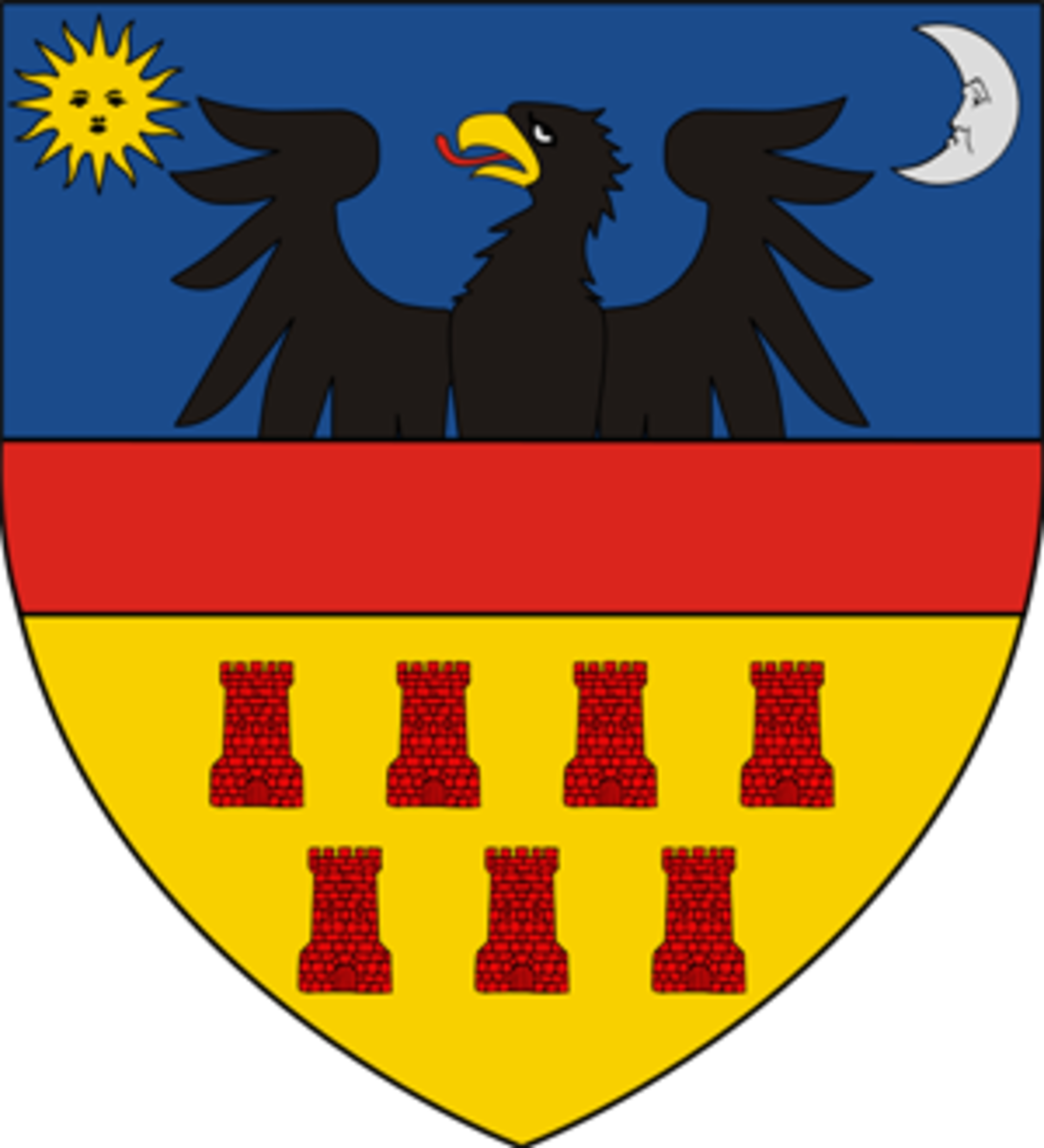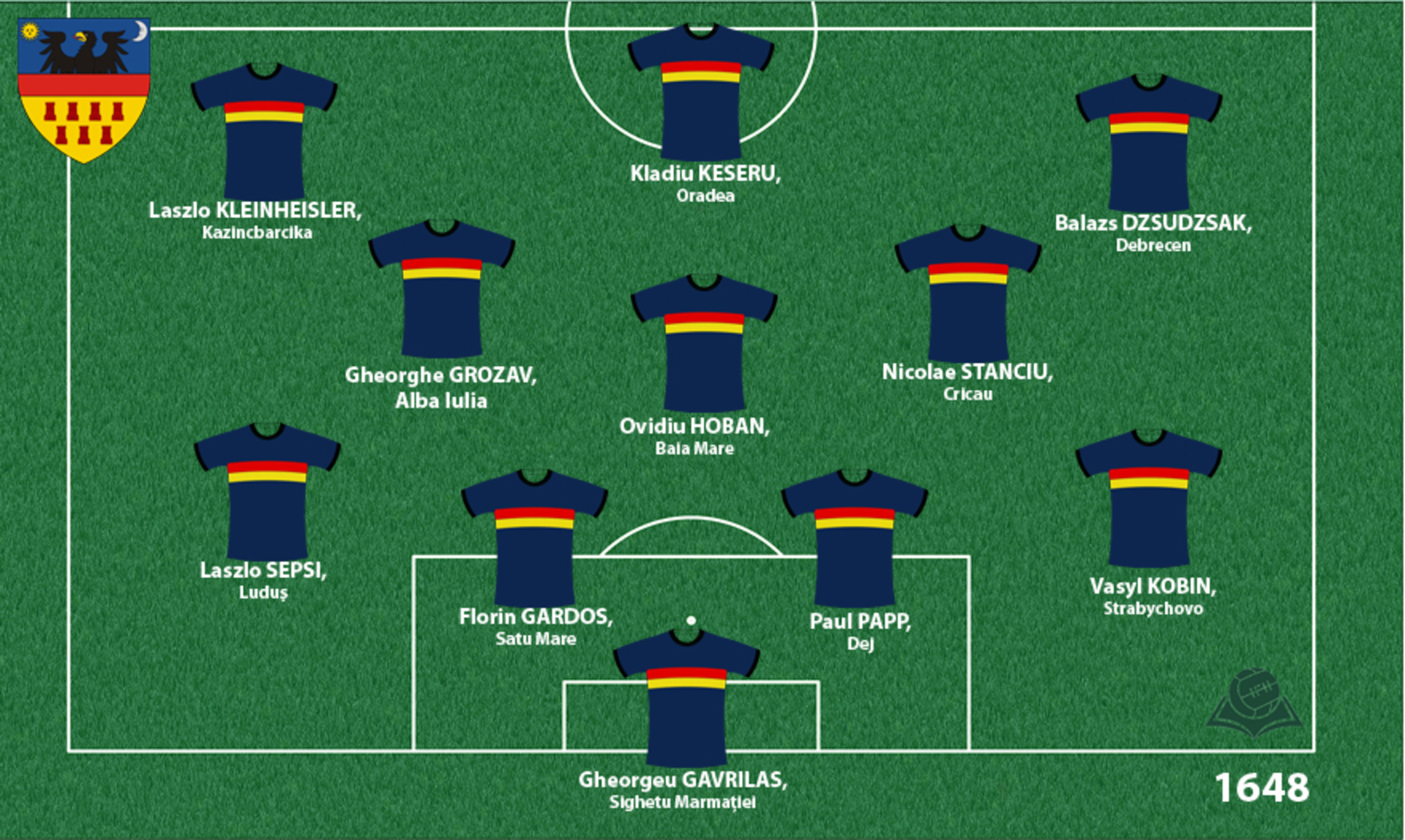The Principality of Transylvania
Erdélyi or Transylvania became a principality in the second half of the 16th century, as a result of the accord between its nobility and the new Hungarian king from the Habsburg family. Its nobility considered themselves the bearers of the tradition of the Kingdom of Hungary, whose large portion of territory came under Ottoman rule during the 16th century.

Coat of arms

Shirt
| Position | First name | Last name | Mjesto rođenja | Like | Dislike | |
|---|---|---|---|---|---|---|
| GK | Georgeu | GAVRILAS | Sighetu Marmaţiei |
1 |
0 |
|
| GK | Marek | RODAK | Košice |
1 |
1 |
|
| DC | Florin | GARDOS | Satu Mare |
1 |
0 |
|
| DC | Gabriel | TAMAS | Brasov |
1 |
0 |
|
| DC | Razvan | HORJ | Moisei |
1 |
0 |
|
| DRLC | PAPP | Paul | Dej |
1 |
0 |
|
| DRLC | Vilmos | VANCZAK | Miskolc |
1 |
0 |
|
| DRL/MR | Vasyl | KOBIN | Strabychovo |
1 |
0 |
|
| DLC/ML | Laszlo | SEPSI | Luduş |
1 |
0 |
|
| DL/AML | Cristian | GANEA | Bistrița |
1 |
0 |
|
| DL/AML | Mihaly | KORHUT | Debrecen |
1 |
0 |
|
| DMC | Ovidiu | HOBAN | Baia Mare |
1 |
0 |
|
| DMC | Viktor | PEČOVSKY | Brezno |
0 |
0 |
|
| MC | Akos | ELEK | Ozd |
2 |
0 |
|
| MC | Daniel | TOZSER | Szolnok |
1 |
0 |
|
| MC | Paul | ANTON | Bistriţa |
1 |
0 |
|
| MC | Zsombor | BERECZ | Miskolc |
2 |
0 |
|
| MRLC | Adam | BODI | Nyíregyháza |
1 |
0 |
|
| AMC/SS | Eric | BICFALVI | Carei |
1 |
0 |
|
| AMRLC | Ciprian | DAEC | Bistrita |
1 |
0 |
|
| AMRLC | Claudiu | BUMBA | Baia Mare |
1 |
0 |
|
| AMRLC | Dennis | MAN | Vladimirescu |
1 |
0 |
|
| AMRLC | Nicolae | STANCIU | Cricau |
1 |
0 |
|
| AMRL | Balazs | DZSUDZSAK | Debrecen |
2 |
0 |
|
| AMRL | Gheorghe | GROZAV | Alba Iulia |
1 |
0 |
|
| AMRL | Laszlo | KLEINHEISLER | Kazincbarcika |
2 |
0 |
|
| AMRL | Liviu | ANTAL | Şimleu Silvaniei |
1 |
0 |
|
| AMR/DR | Sergiu | HANCA | Târgu Mureș |
1 |
0 |
|
| FRLC | Claudiu | KESERU | Oradea |
1 |
0 |
|
| FRLC | Ioan | HORA | Oradea |
1 |
0 |
|
| FC | George | PUSCAS | Marghita |
1 |
0 |
|
| FC | George | TUCUDEAN | Arad |
1 |
0 |
|
| FC | Norbert | BALOGH | Hajdúböszörmény |
1 |
0 |
Today part of: Transylnaia region in Romania, northeastern part of Hungary, eastern part of Slovakia, piece of western Ukraine)
The Ottoman conquests and the civil war in the first half of the 16th century reduced the Lands of the Crown of Saint Stephen, or the Kingdom of Hungary, to the “Remnants of the Remnants” and the Principality of Transylvania, which was ruled by János Zápolya (John Zápolya), the defeated pretender to the throne of the Kingdom of Hungary. Transylvania had for centuries before the Ottoman conquests of the lands of the Kingdom of Hungary been a province with a separate government, led by a duke. In 1570 Transylvania was finally recognized as a principality which would, from then on, (semi)independently exist for the better part of the next three centuries. At the same time, it had considered itself the bearer of the tradition of the former Kingdom of Hungary. They formally recognized the rule of the Habsburgs, however, when they would feel threatened by them, they would turn to the sultan. The rule of the land was in the hands of the Székely, Hungarian, and Saxon nobility who would elect a prince from the ranks of the local families (Báthory, Bocskay, Bethlen, Rákóczy).
Seen as how the Reformation of that time was undermining the foundations of obedience towards authority and encouraging the opposition towards the government, the Transylvanian rulers allowed the Reformation’s activities in their territory and accept the Reformation themselves, so as to emphasise their independence from the Catholic Habsburgs. During the upheaval of the Habsburg liberation wars against the Ottomans, the Transylvanian nobility feared that Hungary, like Bohemia in 1620, could lose the status of kingdom, and become a Habsburg hereditary land. Consequently they entered long period of uprisings, the first of which was the unsuccessful one led by Imra Thokoly at the end of the 17th century, followed by the one led by Francis II Rákóczi at the beginning of the 18th century. After the latter, the Transylvanian nobility definitely recognized the Habsburgs as Hungarian kings (1711), and the Habsburgs, in return, confirmed all of their feudal privileges within their mutual state. The Principality of Transylvania was thus given a great deal of autonomy that they would keep until the Austro-Hungarian Compromise in 1867.
Sources
- Mario JAREB, Hrvatski nacionalni simboli, Zagreb, 2010
- Geza PALFFY, '' Prekogranična povezanost Nikole IV. i Nikole VII. Zrinskog '', Susreti dviju kultura: obitelj Zrinski u hrvatskoj i mađarskoj povijesti (gl.ur. Romana Horvat), Zagreb, 2012., 117-163
- Alan John Percivale TAYLOR, Habsburška monarhija: 1809-1918., Zagreb, 1990.
- Károly KOCSIS, Eszter KOCISISNE HODOSI, ''Ethnic Geography of the Hungarian Minorities in the Carpathian Basin'', https://books.google.co.uk/books?id=zZ_NVM9mNEC&pg=PA106&dq=principality+of+transylvania&hl=en&sa=X&ei=CDMMUe2ZFcqp0AXoyYDIDw#v=onepage&q=principality%20of%20transylvania&f=false
- ''Transilvanija'', http://www.enciklopedija.hr//natuknica.aspx?ID=62040
- Coat of arms: https://en.wikipedia.org/wiki/Historical_coat_of_arms_of_Transylvania
